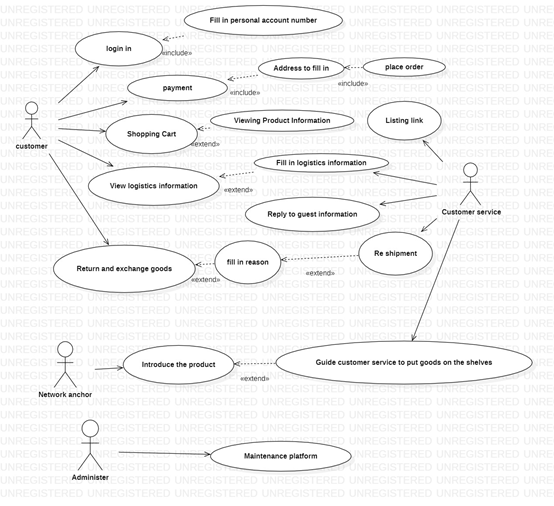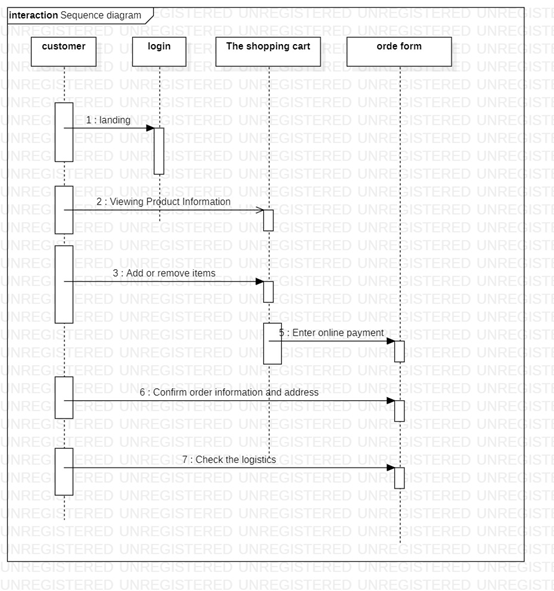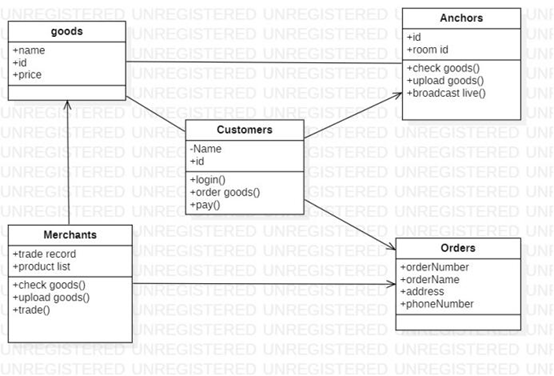| The Link Your Class | https://bbs.csdn.net/forums/MUEE308FZ?category=0 |
|---|---|
| The Link of Requirement of This Assignment | https://bbs.csdn.net/topics/603386400 |
| The Aim of This Assignment | Git/GitHub Using & Keywords Capturing |
| MU STU ID and FZU STU ID | 19105932_831902104 |
Requirement
1. Please issue your Lab Blog on CSDN.
2. The Link of your blog of this lab and This Lab Sheet (This word file) must be submitted to Moodle, or you will lose the score of this Lab. (VERY IMPORTANT: You should submit TWO things)
3. Modeling must use professional tools.
4. You should EXPLAIN your diagrams in words if necessary.
Question
Live-streaming sale, through some Internet platforms, is a new way of service using live-streaming technology for close commodity display, consultation response, and shopping guide. Merchants can open their own live broadcast room, or employ professional anchors to recommend goods. At present, not only many celebrities flock into this field, but some big companies’ executives are also frequently involved. Please try to design a comprehensive live-streaming sale system.
(1)List some actors that interact with this system. Explain the relevance of each actor.
Your Answer:
In my opinion, it should be divided into the following actors。
1.customer:Buy goods, select the live broadcasting room and goods according to the recommendation of the anchor, and finally buy goods according to demand.
2.Anchor: mainly responsible for recommending product information and some shopping guidance and recommending good products to customers.
3.Administrator: responsible for the management and maintenance of users in the live broadcasting room.
4. Customer service: responsible for the after-sales of some goods and the specific purchase operation of goods.
(ii) Prepare a use case diagram for this system.
I think there are four main participants: 1. Consumer 2. Anchor 3. Administrator 4. Customer service has four main participants.
Customers can register, pay, view shopping cart, view commodity logistics information and return goods.
Customer service has the functions of filling in logistics information, helping customers return and exchange goods, filling in commodity information and so on.
The administrator has the function of maintaining the platform.
The network anchor is responsible for introducing goods and directing customer service to link goods on the shelves.

(iii) Prepare a normal scenario for each use case. (i.e. describe each use case in words)
- The user logs in through the account and enters the live broadcasting room. He can buy the goods in the shopping cart according to the goods recommended by the anchor. At the same time, he can view the details of the goods. In the payment interface, the user can choose the payment method, such as cash on delivery or online payment, and then fill in his own address information. After arrival, he can choose to return or exchange goods. The customer has this right, Contact customer service for relevant operations.
- The customer service will log in to the system, and then help the anchor to link the products on the shelves and reply to some customer information to help customers better understand the product information, and deal with some after-sales services, such as helping customers return and exchange goods.
- After logging into the system, the anchor can open his own live studio, and then introduce his products in the live studio to help customers choose.
- After logging into the system, the administrator is responsible for maintaining the live broadcasting room, such as opening or closing the live broadcasting, and can select some people who interfere with the live broadcasting to expel them
(iv) Prepare sequence diagrams or activity diagrams for primary scenarios. By the way, each scenario can be described by a sequence diagram or an activity diagram, but both diagrams must be used in this question.


(v) Prepare a class diagram for this system. Explain which principles of object-oriented are applied in your design.

(vi) Prepare state diagrams for primary classes.

(vii) Write the skeleton code corresponding to the class diagram in C++, Java, Python, or C#.
Your Answer:
public class Live {
class Customer{
String Name;
}
public boolean Login(String Name,String Password) {
return true;
}
public void AskCustomer() {
}
}
public void Discount() {
}
public void Buy() {
}
}
class NormalCustomer extends Customer{
public void Buy() {
}
public void TipStreamer() {
}
}
class NetworkAnchor{
String name;
int LiveNumber;
public void LiveStream() {
}
}
class CustomerService{
String name;
public void HelpCustomer() {
}
}
class Goods{
String GoodsName;
int Price;
int GoodsID;
}
class Administer{
String password;
public boolean Login(String Name,String Password) {
return true;
}
public void checkGoods() {
}
public void AddNewGoods(String GoodsName,int Price) {
}
public void RemoveGoods(String GoodsName) {
}
}
class LoginRegisterSystem{
int SequenceNumber;
boolean CheckUserName(String Name) {
return true;
}
}
}
